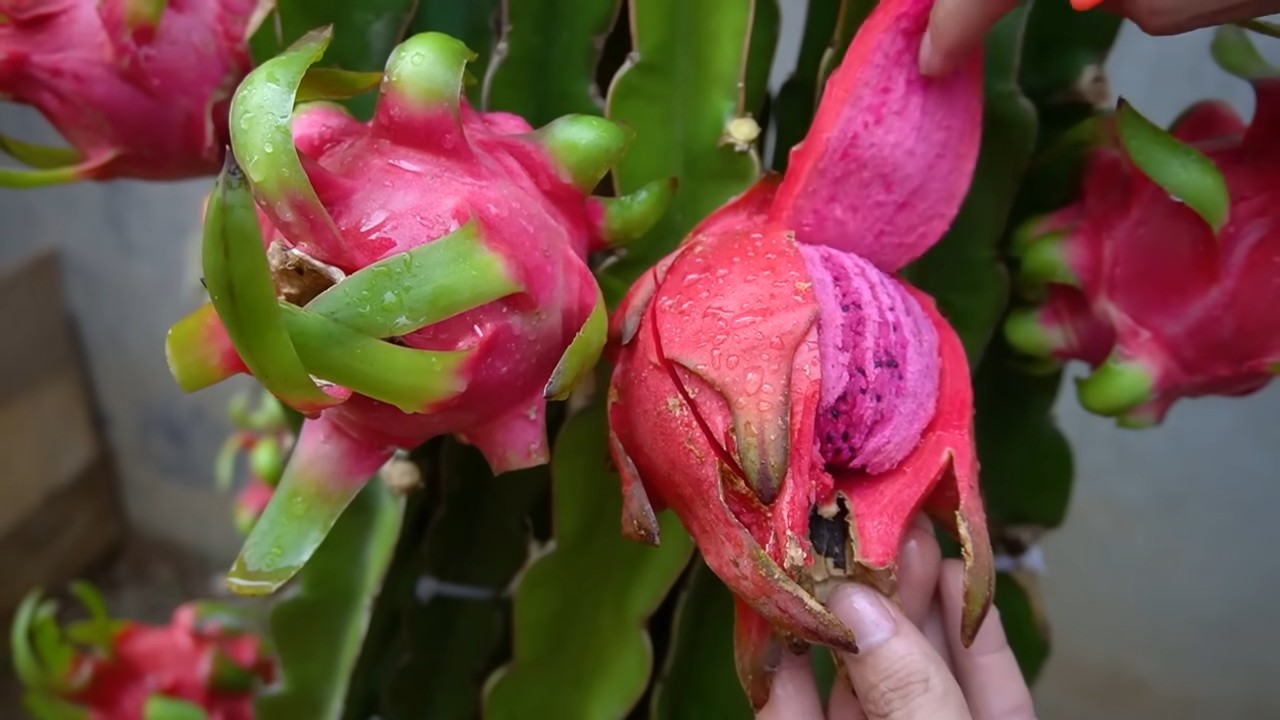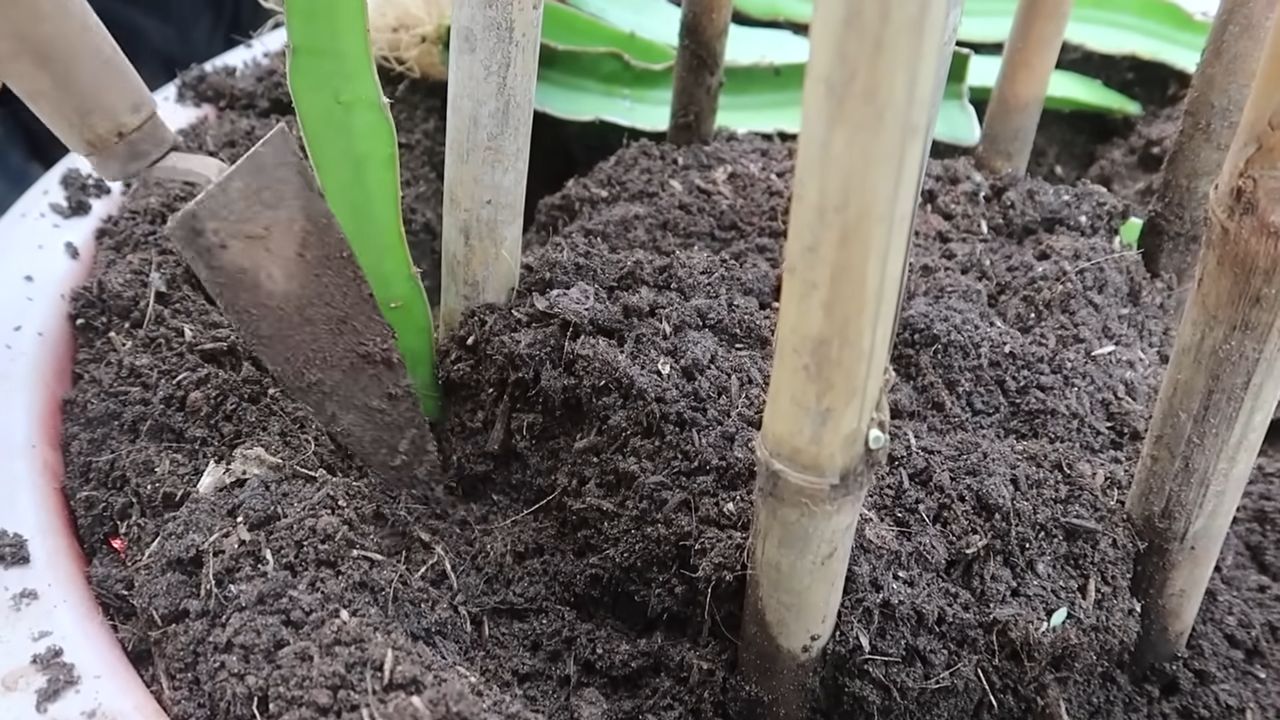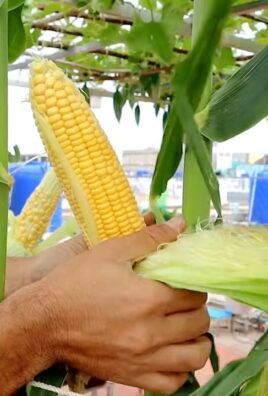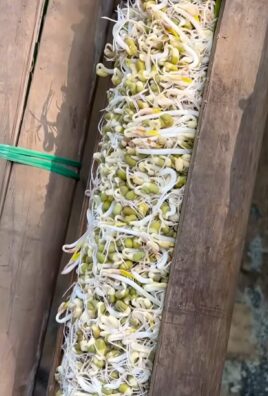Growing Red Dragon Fruit might seem like an exotic dream reserved for tropical climates, but I’m here to tell you that with a few clever tricks and a little DIY spirit, you can cultivate this vibrant and delicious fruit right in your own backyard – or even indoors! Forget those expensive supermarket prices; imagine plucking your own ruby-red dragon fruit, bursting with sweet, slightly tangy flavor.
The dragon fruit, also known as pitaya, has a fascinating history rooted in Central and South America, where it was a staple food for centuries. It later made its way to Southeast Asia, becoming a symbol of prosperity and good fortune in many cultures. Today, its popularity has exploded worldwide, thanks to its unique appearance, nutritional benefits, and relatively easy cultivation.
Why should you embark on this DIY adventure? Well, besides the sheer satisfaction of growing your own food, growing red dragon fruit offers a sustainable and healthy alternative to store-bought options. You’ll know exactly what’s going into your fruit, avoiding harmful pesticides and ensuring maximum freshness. Plus, the dragon fruit plant itself is a stunning addition to any garden or indoor space, with its cascading vines and magnificent, nocturnal blooms. In this article, I’ll share my favorite DIY tricks and hacks to help you successfully grow red dragon fruit, no matter your experience level. Let’s get started!

DIY: Propagating and Growing Red Dragon Fruit at Home
Okay, so you want to grow your own Red Dragon Fruit? Awesome! It’s a rewarding experience, and trust me, nothing beats the taste of a dragon fruit you’ve nurtured yourself. This guide will walk you through the entire process, from propagation to harvesting, ensuring you have the best chance of success. Let’s get started!
Choosing Your Dragon Fruit Cutting
Before we dive into the nitty-gritty, let’s talk about selecting the right cutting. This is crucial for a healthy and productive plant.
* Source Matters: Ideally, get your cutting from a healthy, mature dragon fruit plant that produces good quality fruit. Ask around at local nurseries or even friends who might already be growing them.
* Cutting Size: Aim for a cutting that’s at least 12 inches long, but longer is better (up to 24 inches). A longer cutting has more stored energy and a better chance of rooting successfully.
* Look for Healthy Signs: The cutting should be firm, green, and free from any signs of disease or pests. Avoid cuttings that are yellowing, brown, or have any soft spots.
* Age of the Cutting: A slightly older cutting (a few weeks old) that has had time to callous over at the cut end is preferable. This helps prevent rot.
Preparing Your Dragon Fruit Cutting for Planting
Alright, you’ve got your cutting! Now, let’s get it ready for its new home.
1. Clean the Cutting: Gently wash the cutting with water to remove any dirt or debris. You can use a soft brush if needed.
2. Callousing the Cut End: This is super important! Allow the cut end of the cutting to callous over for about 1-2 weeks. This prevents rot when you plant it. Simply place the cutting in a dry, shaded area, standing upright. You’ll notice the cut end will start to dry and harden.
3. Optional: Rooting Hormone: While not strictly necessary, using a rooting hormone can significantly increase your chances of success. Dip the calloused end of the cutting into rooting hormone powder or liquid, following the instructions on the product label. This encourages faster and more robust root development.
Planting Your Dragon Fruit Cutting
Now for the fun part – planting!
1. Choosing the Right Pot: Dragon fruit needs well-draining soil, so choose a pot with drainage holes. A pot that’s at least 10-12 inches in diameter is a good starting point. You’ll eventually need to transplant it into a larger pot or directly into the ground.
2. Preparing the Soil: Dragon fruit thrives in well-draining soil that’s slightly acidic. A good mix is equal parts potting soil, perlite, and sand. You can also add some compost for extra nutrients.
3. Planting the Cutting: Fill the pot with your soil mixture, leaving a few inches of space at the top. Make a hole in the center of the pot that’s deep enough to accommodate about 2-3 inches of the cutting. Gently insert the calloused end of the cutting into the hole and backfill with soil.
4. Watering: Water the newly planted cutting thoroughly, but be careful not to overwater. The soil should be moist but not soggy.
5. Support: Dragon fruit is a climbing cactus, so it needs support. Insert a sturdy stake or trellis into the pot near the cutting. As the plant grows, you’ll need to tie it to the support.
Caring for Your Dragon Fruit Plant
Okay, you’ve planted your cutting! Now, let’s talk about how to keep it happy and healthy.
1. Sunlight: Dragon fruit needs plenty of sunlight, at least 6-8 hours per day. Place your pot in a sunny location, such as a south-facing window or a patio. If you’re growing it indoors, you may need to supplement with a grow light.
2. Watering: Water your dragon fruit plant when the top inch of soil feels dry to the touch. Avoid overwatering, as this can lead to root rot. During the growing season (spring and summer), you’ll need to water more frequently than during the dormant season (fall and winter).
3. Fertilizing: Feed your dragon fruit plant with a balanced fertilizer every 2-3 months during the growing season. Look for a fertilizer that’s specifically formulated for cacti or succulents.
4. Pruning: Pruning is important for maintaining the shape of your dragon fruit plant and encouraging fruit production. Remove any dead or damaged branches. You can also prune to control the size and shape of the plant.
5. Pest and Disease Control: Dragon fruit is relatively pest-resistant, but it can be susceptible to mealybugs, aphids, and scale. Inspect your plant regularly for signs of pests and treat them promptly with insecticidal soap or neem oil. Root rot is the most common disease, so avoid overwatering.
6. Temperature: Dragon fruit prefers warm temperatures, between 65°F and 80°F. It can tolerate temperatures as low as 32°F for short periods, but it’s best to protect it from frost.
Training Your Dragon Fruit Plant
Dragon fruit plants are climbers, and they need a strong support structure to thrive and produce fruit. Training them properly is key!
* The Importance of a Strong Support: A sturdy trellis or post is essential. Dragon fruit plants can become quite heavy, especially when laden with fruit.
* Types of Support Structures:
* Trellis: A trellis provides a wide surface area for the plant to climb.
* Post: A sturdy wooden or metal post works well, especially if you create a “crown” at the top for the plant to cascade over.
* Training Techniques:
* Guiding the Stems: As the plant grows, gently guide the stems towards the support structure.
* Tying the Stems: Use soft plant ties to secure the stems to the support. Avoid using wire, as it can damage the plant.
* Pruning for Shape: Prune the plant to encourage branching and to maintain a manageable shape. The goal is to create a well-balanced plant that can support a heavy fruit load.
Encouraging Flowering and Fruiting
Getting your dragon fruit plant to flower and fruit can take some patience, but it’s definitely worth the wait!
1. Maturity: Dragon fruit plants typically start to flower and fruit after 1-2 years.
2. Pollination: Most dragon fruit varieties are self-pollinating, but cross-pollination can increase fruit set and size. You can hand-pollinate your plants by transferring pollen from one flower to another using a small brush. Do this at night, as dragon fruit flowers open at night.
3. Watering and Fertilizing: During the flowering and fruiting period, increase watering slightly and fertilize with a fertilizer that’s high in phosphorus and potassium. This will help support fruit development.
4. Environmental Factors: Dragon fruit flowers best when there’s a distinct difference between day and night temperatures.
Harvesting Your Dragon Fruit
Finally, the moment you’ve been waiting for – harvesting your own dragon fruit!
1. Timing: Dragon fruit typically ripens about 30-50 days after flowering.
2. Signs of Ripeness: The skin of the fruit will turn a bright, even color (usually red or pink, depending on the variety). The “wings” or scales on the fruit will start to dry out and turn brown. The fruit should also feel slightly soft to the touch.
3. Harvesting Technique: Use a sharp knife or pruners to cut the fruit from the stem. Leave a small piece of the stem attached to the fruit.
4. Storage: Dragon fruit can be stored in the refrigerator for up to a week.
Troubleshooting Common Problems
Even with the best care, you might encounter some challenges. Here are a few common problems and how to address them:
* Yellowing Leaves: This can be caused by overwatering, underwatering, or nutrient deficiencies. Adjust your watering schedule and fertilize your plant if needed.
* Root Rot: This is usually caused by overwatering. Make sure your soil is well-draining and avoid letting the plant sit in water.
* Lack of Flowering: This can be caused by insufficient sunlight, lack of nutrients, or immature plants. Ensure your plant is getting enough sunlight, fertilize it regularly, and be patient.
* Pests: Inspect your plant regularly for pests and treat them promptly with insecticidal soap or neem oil.
Final Thoughts
Growing your own Red Dragon Fruit is a journey, but it’s a rewarding one. With a little patience and care, you’ll be enjoying delicious, homegrown dragon fruit in no time. Don’t be

Conclusion
So, there you have it – a comprehensive guide to successfully growing your own Red Dragon Fruit! We’ve covered everything from selecting the right cutting or seedling to providing the optimal growing conditions and patiently waiting for those vibrant, delicious fruits to appear. But why should you embark on this journey of growing Red Dragon Fruit at home? The answer is multifaceted.
Firstly, the taste. Commercially grown dragon fruit, while visually appealing, often lacks the intense sweetness and nuanced flavor that homegrown varieties can achieve. When you nurture your own plant, you have complete control over its environment, ensuring it receives the precise nutrients and care it needs to develop its full potential. Imagine biting into a perfectly ripe, ruby-red dragon fruit, bursting with a flavor that far surpasses anything you’ve ever tasted from a supermarket. That’s the promise of growing your own.
Secondly, the satisfaction. There’s an undeniable sense of accomplishment that comes from nurturing a plant from a small cutting or seedling into a thriving, fruit-bearing specimen. Watching your Red Dragon Fruit plant climb and produce its exotic blooms is a rewarding experience in itself. And when you finally harvest your first fruit, the feeling of pride and accomplishment is truly unmatched.
Thirdly, the health benefits. Dragon fruit is packed with antioxidants, vitamins, and fiber, making it a nutritional powerhouse. By growing your own, you can ensure that your fruit is free from harmful pesticides and chemicals, providing you and your family with a healthy and delicious treat.
But the journey doesn’t end here! Feel free to experiment with different growing techniques. Try different soil mixes to see what works best in your climate. Consider using organic fertilizers to further enhance the flavor and nutritional value of your fruit. You can even try grafting different varieties of dragon fruit onto a single plant to create a unique and diverse collection.
For those in colder climates, consider growing your Red Dragon Fruit in a large pot that can be moved indoors during the winter months. This allows you to enjoy the beauty and bounty of this tropical fruit even in less-than-ideal conditions. You can also explore different trellising methods to maximize space and sunlight exposure. A sturdy trellis is essential for supporting the heavy fruits and preventing the plant from becoming unruly.
Don’t be afraid to get creative and adapt these techniques to suit your specific needs and preferences. The key is to be patient, observant, and willing to learn from your experiences.
We strongly encourage you to give growing Red Dragon Fruit a try. It’s a rewarding and delicious experience that you won’t regret. And once you’ve harvested your first crop, be sure to share your success with us! We’d love to hear about your experiences, see photos of your plants, and learn any tips or tricks you’ve discovered along the way. Share your journey on social media using relevant hashtags and inspire others to embark on their own dragon fruit adventures. Let’s build a community of dragon fruit enthusiasts and share the joy of growing this amazing fruit!
Frequently Asked Questions (FAQ)
What is the best time of year to plant Red Dragon Fruit?
The ideal time to plant Red Dragon Fruit is during the spring or early summer months. This allows the plant to establish itself and develop a strong root system before the onset of colder weather. In warmer climates, you can plant year-round, but avoid planting during periods of extreme heat or drought. If you are starting from a cutting, ensure it has calloused over properly before planting to prevent rot.
How much sunlight does Red Dragon Fruit need?
Red Dragon Fruit thrives in full sun, requiring at least six to eight hours of direct sunlight per day. Adequate sunlight is crucial for flowering and fruit production. If you are growing your plant indoors, place it near a south-facing window or supplement with artificial grow lights. Insufficient sunlight can lead to stunted growth and reduced fruit yield.
What type of soil is best for Red Dragon Fruit?
Red Dragon Fruit prefers well-draining soil that is rich in organic matter. A slightly acidic to neutral pH (6.0-7.0) is ideal. You can create a suitable soil mix by combining equal parts of potting soil, compost, and perlite or sand. Avoid heavy clay soils, as they can retain too much moisture and lead to root rot. Good drainage is essential for the health of your Red Dragon Fruit plant.
How often should I water my Red Dragon Fruit plant?
Water your Red Dragon Fruit plant regularly, especially during the growing season. Allow the soil to dry out slightly between waterings, but avoid letting it dry out completely. Overwatering can lead to root rot, while underwatering can stress the plant and reduce fruit production. Adjust your watering schedule based on the weather conditions and the moisture content of the soil. During the winter months, reduce watering frequency.
How do I fertilize my Red Dragon Fruit plant?
Fertilize your Red Dragon Fruit plant regularly during the growing season with a balanced fertilizer. A fertilizer with a ratio of 10-10-10 or 20-20-20 is suitable. Apply the fertilizer according to the manufacturer’s instructions. You can also supplement with organic fertilizers such as compost tea or worm castings. Avoid over-fertilizing, as this can burn the roots and damage the plant. During the dormant season, reduce or eliminate fertilization.
How long does it take for Red Dragon Fruit to produce fruit?
Red Dragon Fruit plants typically begin to produce fruit within one to three years of planting, depending on the variety and growing conditions. Plants grown from cuttings tend to fruit sooner than those grown from seeds. Proper care, including adequate sunlight, water, and fertilization, is essential for promoting fruit production. Be patient and consistent with your care, and you will be rewarded with delicious fruit.
What are some common pests and diseases that affect Red Dragon Fruit?
Red Dragon Fruit plants can be susceptible to pests such as aphids, mealybugs, and spider mites. Regularly inspect your plant for signs of infestation and take appropriate action, such as spraying with insecticidal soap or neem oil. Common diseases include stem rot and fungal infections. Ensure good air circulation and avoid overwatering to prevent these problems. If you notice any signs of disease, treat the plant with a fungicide.
How do I prune my Red Dragon Fruit plant?
Pruning is essential for maintaining the shape and health of your Red Dragon Fruit plant. Remove any dead, damaged, or diseased branches. Prune back long, trailing stems to encourage branching and fruit production. You can also prune to control the size and shape of the plant. The best time to prune is after the plant has finished fruiting.
How do I know when my Red Dragon Fruit is ripe?
A ripe Red Dragon Fruit will have a vibrant, even color and a slightly soft texture. The skin should be smooth and free from blemishes. The fruit should also have a slight give when gently squeezed. You can also check the “wings” or scales on the fruit; they should start to dry out and turn brown. The fruit will also detach easily from the plant when ripe.
Can I grow Red Dragon Fruit in a container?
Yes, Red Dragon Fruit can be successfully grown in a container, especially in regions with colder climates. Choose a large pot with good drainage and use a well-draining soil mix. Provide a sturdy trellis or support structure for the plant to climb on. Water and fertilize regularly, and protect the plant from frost during the winter months. Container-grown Red Dragon Fruit may require more frequent watering and fertilization than plants grown in the ground.




Leave a Comment